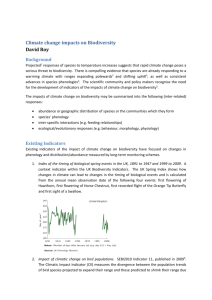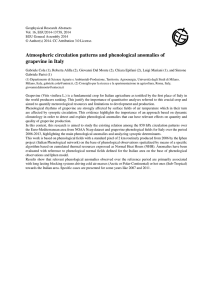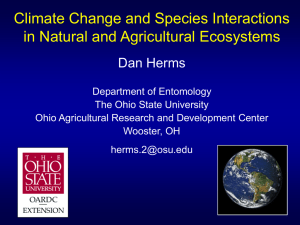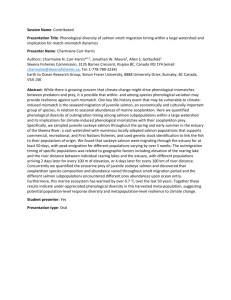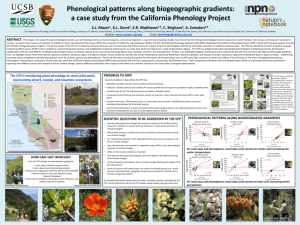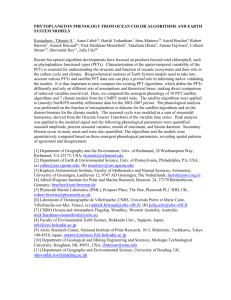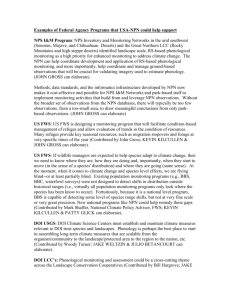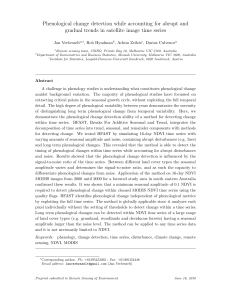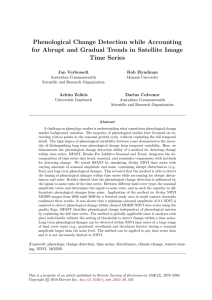Climate/Hydro Group - USA National Phenology Network
advertisement
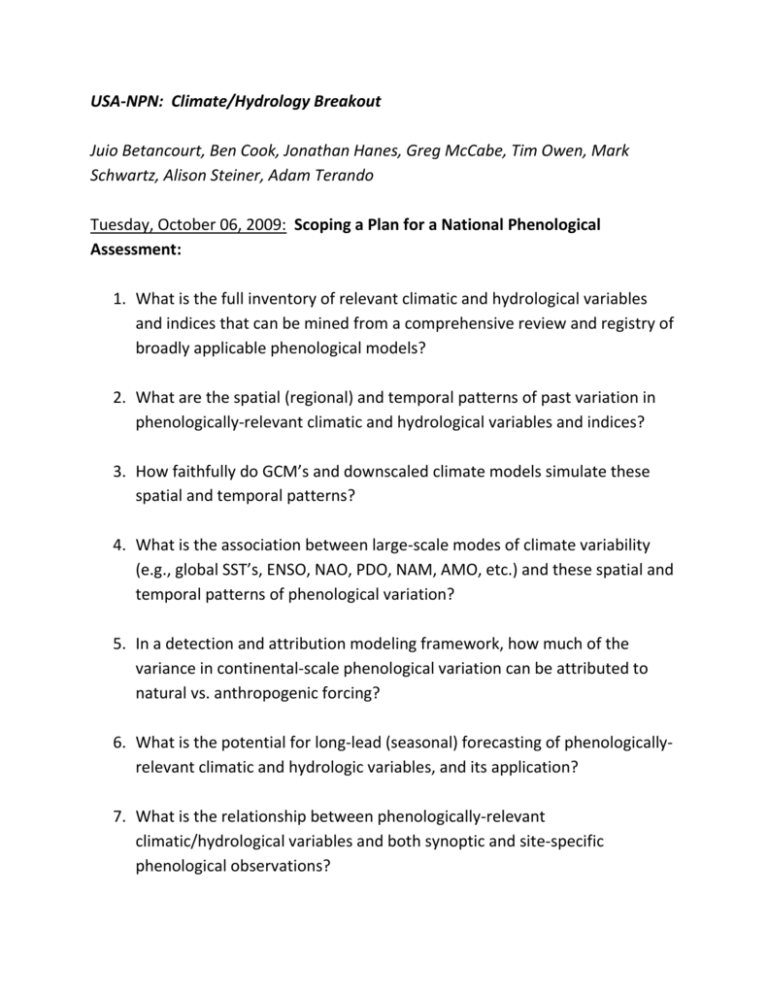
USA-NPN: Climate/Hydrology Breakout Juio Betancourt, Ben Cook, Jonathan Hanes, Greg McCabe, Tim Owen, Mark Schwartz, Alison Steiner, Adam Terando Tuesday, October 06, 2009: Scoping a Plan for a National Phenological Assessment: 1. What is the full inventory of relevant climatic and hydrological variables and indices that can be mined from a comprehensive review and registry of broadly applicable phenological models? 2. What are the spatial (regional) and temporal patterns of past variation in phenologically-relevant climatic and hydrological variables and indices? 3. How faithfully do GCM’s and downscaled climate models simulate these spatial and temporal patterns? 4. What is the association between large-scale modes of climate variability (e.g., global SST’s, ENSO, NAO, PDO, NAM, AMO, etc.) and these spatial and temporal patterns of phenological variation? 5. In a detection and attribution modeling framework, how much of the variance in continental-scale phenological variation can be attributed to natural vs. anthropogenic forcing? 6. What is the potential for long-lead (seasonal) forecasting of phenologicallyrelevant climatic and hydrologic variables, and its application? 7. What is the relationship between phenologically-relevant climatic/hydrological variables and both synoptic and site-specific phenological observations? Climate Data: Model Calibration/Validation/Prediction o Reanalysis versus observed gridded input o Spatial and temporal granularity Regional versus continental scale Biosphere domain (ocean/atmosphere/surface) Models have limitations (e.g., monthly snow cover) o Ensemble versus. stand-alone o Uncertainty characterization o Statistical versus mechanistic/deterministic approaches Downscaling; work in anomaly space Signal-to-noise issue (annual versus longer-term) o Simulate growing degree days or other phenological indicator as a function of climate modes and secular change: Detection attribution through statistical simulation of relevant phenology forcing variables. o Models must be able to handle desired spatial and temporal modes at the continental scale (do they get the variance right). Data Observations o In-situ versus remotely-sensed data o Instrumental versus proxy sources o Hydrological measures (e.g., streamflow, water temperature, snow pack) o Solar forcing measures (e.g., latent and sensible heat fluxes) o Pre-requisite data needs Daily precipitation Daily max/min temperature Others (snowfall/depth,ET, soil moisture) o Correlation to phenological measures Phenological Data: Detection (Schwartz spring indices – Correlation of first leaf and and grassland; first bloom and forest land) o Species selection: native, domesticated, invasive Traditional measures (e.g., birds, lilacs, wheat) o Seasonal pulses and baseline growth characteristics o Force/Feedback Paradigm (Identifying direct and coincidental impacts) Detectability: Sharpness of response (e.g., bud break versus time of full bloom); step changes vs. gradual trends. Attribution (Habitat change example: climate change – jet stream shift – biennial oscillation stops - cone production in boreal conifers drops – bird population impact) Spatial range of phenological measures (Local [egg-laying insects and plants] vs. migratory [birds]) Data Rescue o Digitization: Scanning and keying of data Product Development: Relevance (Utility of output for managers and decision makers) Accessibility/Usability (Thresholds, bounds, indices) o Biogeography (distribution) model o Non-stationary vs. equilibrium models o Species range models o Phenological indicator inputs into statistical models Familiarity (Plant hardiness mapping, migratory mapping) Client/Stakeholder Delineation Registry of Data Sources Slide: GCMs and Downscaling – what are the gridded products available (pros and cons)? Katherine Hayhoe approach to downscaling. Work in anomaly space. (Adam, Ben, Allison) Potential Contributors to NPA-Climate/Hydrology: Noah Diffenbaugh, Stanford U. Claudia Tebaldi, UBC, Vancouver Wednesday, October 07, 2009 and Thursday, October 08, 2009: Short-Term Product Development Options: Patterns and Drivers of Spring Onset Variations Over North America: Extend Western U.S. Product (265 Historical Climatology Stations (HCN) stations) to conterminous U.S. and Canada in lilac growing zone. Continental PCA analysis; significant PCs related to hemispheric climate indices. Goal: First approximation of modes of variation and baseline of spring onset at continental scale. Extension of Cayan et al. 2001 BAMS work. Target Journals: Climate Dynamics, Journal of Climate, or BAMS. Data Sources: Schwartz Spring Indices Database, NCDC GHCNv2 (homogenized daily data). Period of record: 1900-present. Players: Mark Schwartz, Greg McCabe, Julio Betancourt, Ben Cook, Allison Steiner, Toby Alt (Perspectives) Informing Phenological Models for the IPCC Fifth Assessment Report (Review) Assessments, Applications, and Recommendations for Global Change Studies Using Phenological Models: Most commonly used variables and essential algorithms related to phenology. 1. Overview of species-level models (including plants, insects, birds, crops, etc.) highlighting paucity of models and sequence dependencies (successive consecutive conditions that trigger phenological events). 2. Discussion of regional- to continental-scale models (e.g., green-up, remotely-sensed approaches) 3. Overview of data availability and data needs for doing regional- to continental-scale phenological work in the context of IPCC-archived variables (consider uncertainties of using climate models to force phenology models, and need for multi-model approaches). Emphasis on phenology for assessment in non-stationary climate. Goal: Provide overview of both climate and phenological models and desired resources for future assessment. Target Journals: Global Change Biology and Science (Perspectives Section) Data Sources: USDA Data Sources; NCDC GHCNv2 (homogenized daily data). Period of record: 1960-present. Players (Review): Ben Cook, Allison Steiner, Adam Terando, Mark Schwartz; Perspectives: TBD Temporal Evolution of Plant Hardiness Zones: Work collaboratively with USDA to evaluate plant hardiness zone computations and underlying dynamics. Goal: Develop annual historic maps for the past fifty years for posting to USANPN, with decade-by-decade changes and projections for future decades. Target Journals: Global Change Biology or Journal of Climate Data Sources: USDA Data Sources; NCDC GHCNv2 (homogenized daily data). Period of record: 1960-present. Players: Tim Owen, Adam Terando, Bill Hargrove, Geoff Henebry Assimilation of Legacy Phenological Data Sets for North America: A Proposal to the National Center for Ecological Analysis and Synthesis (NCEAS; UC-Santa Barbara): Revisit proposal idea, focusing on measured phenological behavior relevant to climate change modes of variability. Goal: Bring phenological sets into common format (with defined input standards) for use by National Phenology Network. Target Proposal Submission: NCEAS (work with Lizzie Wolkovich); Deadline: January 11, 2010. Data Sources: Phenology data sets: (Taxa: WF-woody ora, HF-herbaceous ora, AVavifauna, HE-herpifauna, IN-insects, MA-mammals). *Datasets with wide geographic coverage: Dataset Bird Migrations Bird Migrations Bird Migrations Bird Migrations Bird Migrations Bird Migrations Cherry Blooming Concord Flowering Flowering Location Cambridge, MA Cayuga Lake Basin, NY Maine Maine Manomet, MA Worcester, MA Washington, DC Concord, MA Concord, MA Concord, MA Taxa AV AV AV AV AV AV WF AV HF, WF HF, WF Timespan 1980-2004 1903-1993 1899-1911 1994-2008 1970-2002 1932-1993 1921-Present 1852-Present 1963-1994 1852-1857 Flowering Concord, MA Flowering Concord, MA Gothic Gothic, CO Konza Prairie Kansas Leopold Data Wisconsin *Lilac Network (East) USA *Lilac Network (West) USA Middleborough Middleborough, MA Mohonk Lake New Paltz, NY *NA Bird Phen Prog USA United Kingdom United Kingdom *Wheat Headings (Spring) USA *Wheat Headings (Winter) USA Wisconsin Phen. Soc. Wisconsin HF, HF, WF 1878, 1888-1902 HF, WF 2003-2006 HF, WF, IN, AV, MA 1973-2008 HF, WF 1981-1988, 2001-Present HF, WF, AV, MA 1935-1945 WF 1961-Present WF 1956-Present HF, WF, AV, HE, IN 1970-2002 WF, HF, AV, HE 1925-Present AV 1881-1970 WF, HF 1954-2000 HF 1931-Present HF 1931-Present WF 1962-Present Players: Ben Cook, Julio Betancourt, Elizabeth Wolkovich Explore complexity through linear assumptions of drivers of phenological change, considering suite of indicators (where each indicator is a hypothesis): Comparison Matrix for Potential Indicators of Phenology (PIPs): Layers Ecological Impacts Phenological Behavior Potential Indicators of Phenology (PIPs) Environmental Consequences Climatic Drivers Budworm Emergence Defoliation First Bloom Spring Index Fire Natural Variability and Anthropogenic Change NW SW Space (i.e., Regions) MW SE NE Far Past Past Present Future Far Future Time (i.e., Observational Period of Record) Research, Monitoring, and Management Implications

